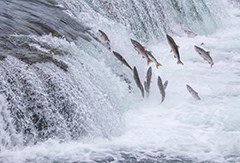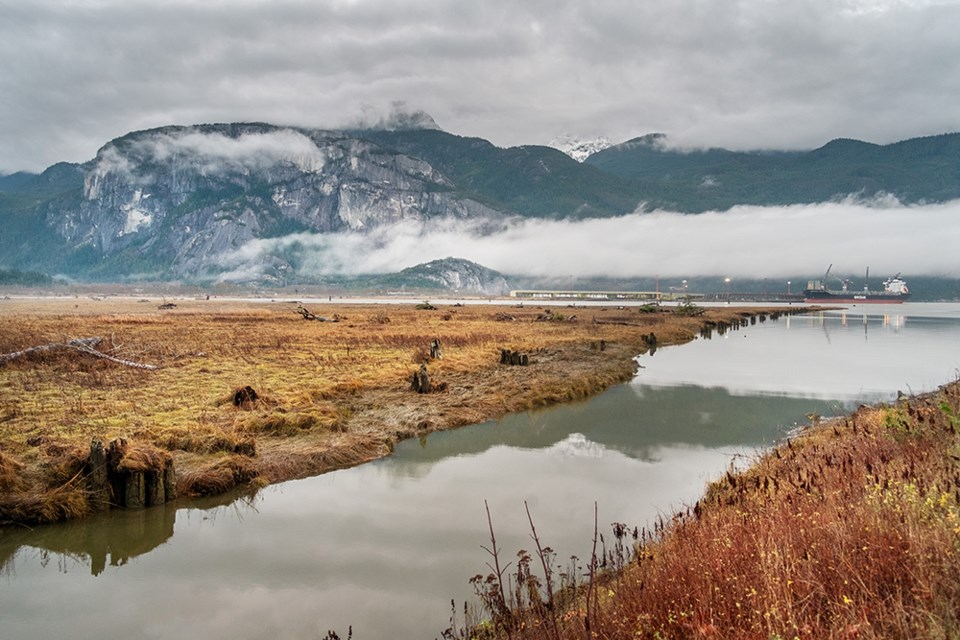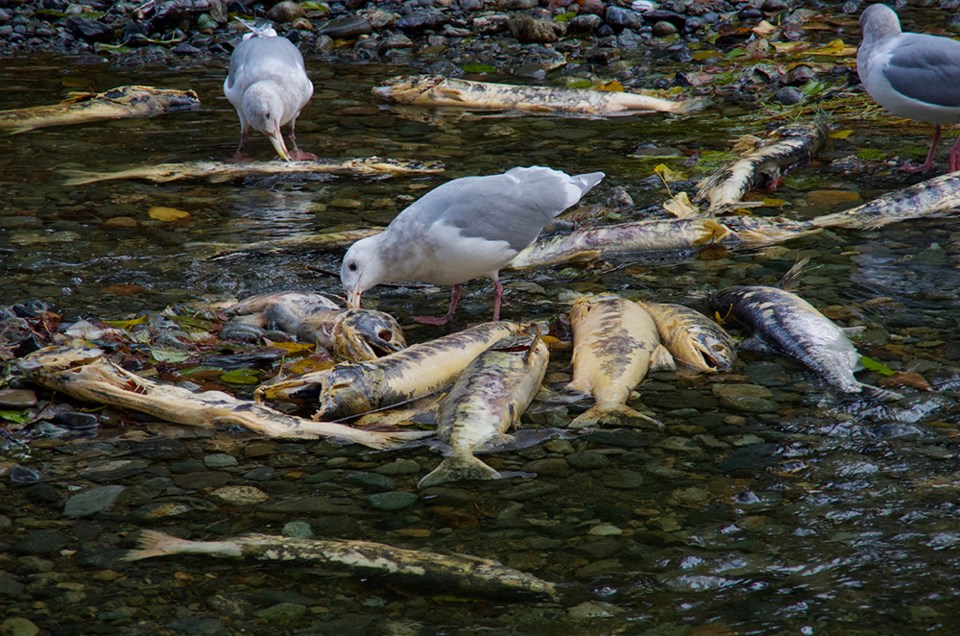The numbers of chum salmon returning to spawn in the Squamish River and nearby waterways this year is being called "abysmal" and the lowest in years by local fishers. And while chum are not highly prized for human consumption, they are essential to a healthy ecosystem in the area —including everything from insects to grizzly bears.
In November, the federal Department of Fisheries and Oceans banned the retention of Squamish River chum due to low numbers.
This month, 13 populations of chinook salmon in B.C. were added to a list of at-risk species by the Committee on the Status of Endangered Wildlife, an indication of "an ecosystem in crisis," according to the World Wildlife Fund Canada. And while the chinook deemed at-risk are on Vancouver Island, and in the Fraser and Thompson rivers, people close to the fishery in the Squamish area see a dire omen in this year's chum numbers.
The Squamish, Mamquam, Cheakamus and Elaho rivers sustain four varieties of Pacific salmon: coho, chinook, pink and chum. The latter is popular for smoking and canning. Chum flesh and eggs are often exported, primarily to Asia, while domestic uses include animal food and bait. Regarding value on the market, chum are perhaps the least desirable salmon, but their role in the environment — including sustaining other types of salmon as well as mammals and even vegetation — make them a harbinger of environmental health or crisis.
"They make the whole ecosystem tick," said Dave Brown, chair of the Sea to Sky Fisheries Roundtable and vice-chair of the Squamish Lillooet Sportfish Advisory Committee. "They ask very little of the resource."
While other salmon may remain in the river for two to three years, relying on the largesse of the river ecosystem for sustenance as they grow, chum migrate to the ocean as fry, just an inch or two in length.
When they return to the river, weighing 10 to 25 pounds, they lay their eggs, many of which become food for the other fish, either as eggs or as fry, and the dead chum provide protein for everything from algae and insects to eagles, wolves, bobcats, grizzlies and black bears, even deer. Their remains fertilize the surrounding trees, which provide bank stabilization and shade that regulates the water temperature.
"They're not taxing the river's resources, and they are creating nutrients," Brown said. "Without a healthy chum population, the other salmon populations are going to perform poorly."
Brown said this year's chum numbers are the lowest that he's seen since he started fishing in the area, in the early 1990s.
There is no conclusive explanation for the seeming collapse of the chum population, but there is also no shortage of theories. Any or all of the factors may play a role — and the likeliest cause is some combination of all the theories.
Brown cites two theories in particular. He is concerned that migrating wild fish are interacting with farmed fish, permitting the transmission of sea lice and pathogens into the wild population. He would like to see land-based, or at least fully self-contained, salmon aquaculture.
Shawn Hall, spokesperson for the B.C. Salmon Farmers Association contradicted Brown’s fish farm concerns.
“The body of science tells us that salmon farms and wild salmon populations can exist in the ocean as long as salmon farmers continue to behave responsibly — as we do here in British Columbia,” he said. “We are one of the most regulated food growing industries in Canada…. About three quarters of the salmon that are harvested in B.C. each year are farm-raised and so farmed salmon plays a crucial role in protecting wild salmon populations from over-fishing by providing a supply.”
Brown is also concerned that there is a lack of data being collected on salmon from the Squamish River and other area waterways. There is a lack of data being collected on fish being caught in Johnstone Strait and elsewhere in the Salish Sea to determine the salmon's rivers of origin, he said.
"We've been asking for years to do genetic sampling on Squamish chum so we can have the necessary data so we can have the DNA to determine how many Squamish chum are being caught in these commercial fisheries that are taking place," he said. "Right now, we are doing best estimates or guesses. Stock assessment is crucial if you want to manage a stock properly."
Brown acknowledges that there are probably other factors at play, including ocean conditions and climate change. But, whatever the causes, he said, "It's just abysmal this year."
"It's the worst year I've ever seen for the chum salmon, for sure," agreed Clint Goyette, owner of Valley Fishing Guides since 2000. "It affects all the wildlife that rely on the chum. This is the first year I've ever seen grizzly bear activities on the Squamish. I can only assume that that's due to them looking for food instead of hiding from humans … looking for the food that isn't there."

He blames the trend on the Johnstone Strait chum fishery, which began in 2006, after which, he said, "We saw an immediate decline in chum salmon coming back to the Squamish" and other local rivers.
He accuses the federal government of permitting overfishing.
"They refuse to use known scientific methods," Goyette said. "[The Department of Fisheries and Oceans] just don't want to know what they are exploiting because if they don't know then they can continue to do what they are doing, which is exactly why we are in the position that we are now."
Mike Holmes, who has been fishing in the Squamish River for eight years has noticed declining numbers of chum, coho, and pink salmon. He thinks flooding at critical times may be partly to blame — but that, he said, "can't be the only explanation."
Squamish Streamkeeper Jack Cooley said he's watching for returning coho numbers, which will be completed in February. While his numbers show chum counted at Chuck Creek as good or slightly better than last year, he's worried about next year's Coho numbers.
The Chief sought comment from federal fisheries officials. In an email exchange, a representative contested some assertions from sources in this story, but neither the official nor the regional DFO communications office, had provided further clarification by press time.
Brian Riddell is president and CEO of the Pacific Salmon Foundation. Prior to this, he had a 30-year career in the science branch at the Department of Fisheries and Oceans. He co-authored Canada's Policy for Conservation of Wild Pacific Salmon and established the Salish Sea Marine Survival Project
A look at this year's salmon numbers, he said, provides a mixed bag.
"In some places, I find the return was OK, in other places not OK," he said, acknowledging that neither he nor anyone else seems able to pin down precise causes for declines in a given area.
He called the idea that salmon farms along the coast are contaminating wild species "pretty speculative."
"A lot of people are talking about the salmon farms and certainly the [Pacific Salmon] Foundation has, after years of working in that area, taken the stance that there is evidence of risk of disease transfer, pathogen transfer, but to account for a huge failure, that's a bit of a stretch," he said. "But, to be honest, we don't really know, so we can't dismiss it."
Chinook salmon, all along the Pacific coast of the U.S. and Canada, are having what is called a period of poor "marine productivity."
"A lot of the return rates are down and that's not one location, that's right across the board in many areas," he said.
Part of the cause could be a result of the so-called "warm-water blob," a swath of warmer-than-average water in the North Pacific that was first identified in 2013.
"I don't think there is any question that it has affected salmon more than people had expected," he said. Lower spawning returns and changes in the usually dependable timing of spawning cycles are some of the phenomena he thinks might be attributable to the blob.
Where Riddell takes exception to common perceptions is around the idea that salmon stocks have experienced a steady falling-off over decades.
"A lot of people think that it's been a long-term decline, but the peak historic catches in B.C., in terms of commercial fishing, was really in the late '90s," he said. "It was stable for a long time in the '50s and then it actually grew. But as it grew, there was an element of overfishing where the stocks were declining. … Then we started seeing these declines in production in some areas. It's really not a steady decline. It's much more variable than that."
When stocks decline in localized areas, Riddell said, experts look first to local explanations, then expand out. For example, sockeye stocks in the Lower Fraser Valley were stable for a long time until development around Cultus Lake changed the chemistry of the water, to the sockeye's detriment.
Development on the water and foreshore around Squamish could be having impacts on salmon, Riddell said. But he credited work going on to restore the Squamish Estuary as very positive and useful.
"Estuaries are really important habitat for salmon," he said. The fish shift in their physiology from fresh water to salt water during time spent in the estuary. "Smaller salmon — pink, chum, small chinook — they will use estuaries extensively, first starting to rear for three or four months there before they even get out to sea. The bigger salmon, typically the coho and steelhead, they will use it temporarily to adjust, but then they go out to sea."

Riddell also takes exception to a negative or defeatist attitude on the issue.
The federal government recently announced $100 million over five years for restoration of Pacific salmon habitats.
"We haven't seen a commitment and a source of funds like that here in a long time," he said.
The province is also seeking input on the subject and may be on the verge of a major funding announcement, he said.
"The negativity on the issue is really not a good way to go," Riddell said. "We can't have people thinking that it's defeated [or that] they are gone. We really have to be a lot more positive, because we can recover these guys. They are highly resilient. They are really an amazing animal. There are reasons for optimism."




